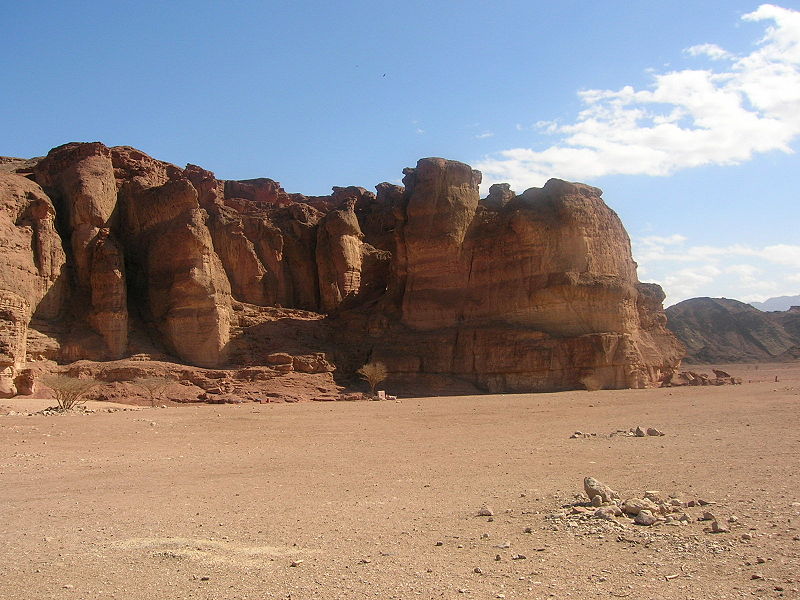30 Aug. Solomon furnishes the Temple in Jerusalem
“King Solomon sent to Tyre and had Huram brought to him. Hurum’s mother was a widow from the tribe of Naphtali. His father was from Tyre and had been skilled in making things from bronze. Huram was also very skilled and experienced in bronze work. So he came to King Solomon and did all the bronze work.”
“He made two bronze pillars, each one 9 metres tall and 6 metres around. He also made two bronze capitals that were 2.5 metres tall, and he put them on top of the pillars. Then he made a net of seven chains for each capital, which covered the capitals on top of the two pillars.”
“He made two rows of bronze pomegranates to go on the nets. These covered the capitals at the top of the pillars. The capitals on top of the pillars in the porch were shaped like lilies, and they were 2 metres tall. The capitals were on top of both pillars, above the bowl-shaped section and next to the nets. At that place there were 200 pomegranates in rows all around the capitals…”
“Then Huram made from bronze a large round bowl, which was called the Sea. It was 15 metres around, 5 metres across and 2.5 metres deep. Around the outer edge of the bowl was a rim. Under this rim were two rows of bronze plants which surrounded the bowl. There were 10 plants every 50 centimetres, and these plants were made in one piece with the bowl.”
“The bowl rested on the backs of twelve bronze bulls that faced outwards from the centre of the bowl. Three bulls faced north, three faced west, three faced south and three faced east. The sides of the bowl were 10 centimetres thick, and it held about 40,000 litres. The rim of the bowl was like the rim of a cup or like a lily blossom.”
“Then Huram made ten bronze stands, each one 2 metres long, 2 metres wide and 1.5 metres high. The stands were made from square sides, which were put on frames. On the sides were bronze lions, bulls and creatures with wings. On the frames above and below the lions and bulls were designs of flowers hammered into the bronze. Each stand had four bronze wheels with bronze axles. At the corners there were bronze supports for a large bowl, and the supports had designs of flowers…”
“This is the way Huram made the ten stands. The bronze for each stand was melted and poured into a mould, so all the stands were the same size and shape. Huram also made ten bronze bowls, one bowl for each of the ten stands… Huram also made bowls, shovels and small bowls… Huram made everything King Solomon wanted from polished bronze. The king had these things poured into clay moulds that were made in the plain of the Jordan River between Succoth and Zarethan.”
(1 Kings 7:13-30, 37-38, 45-46)

Today’s passage describes how the Temple was filled with magnificent bronze furnishings, including a bronze altar for burnt offerings (see 1 Kings 8:22, 64 & 9:25), two gigantic bronze pillars with elaborately ornamented capitals, a huge bronze ceremonial washing basin or ‘laver’ (called the ‘Brazen Sea’) and ten smaller portable bronze hand basins resting on ceremonial washing or ‘laver’ stands (see Exodus 30:17-21).
The elegant bronze castings for Solomon’s Temple were made with copper from the mines at Timna in the southern Negev Desert near the Gulf of Aqaba. The copper was taken north to the bronze foundry between Sukkoth and Zarethan in the Jordan Valley (see 1 Kings 7:46), where highly skilled metal workers from the Kingdom of Tyre were employed to produce the bronze alloys needed for the elaborate castings.
The site of King Solomon’s Mines at Timna, about 18 miles / 30 km north of Eilat, can still be visited today. Copper mining began here over four thousand years ago under the Egyptians and the Midianites, reaching its zenith in the time of King Solomon.
In addition to all the bronze furnishings made by Huram of Tyre, Solomon also had many gold fittings made for the Temple, including a golden altar, a golden table to hold the showbread (see Leviticus 25:30), ten gold lampstands, and gold bowls, pans and other dishes used to carry charcoal for burning incense (see 1 Kings 7:48-50).
The photo (by Little Savage) shows the site of King Solomon’s Mines at Timna in the Negev Desert.
You can read more about these mines @ https://thebiblejourney.org/biblejourney2/31-the-golden-age-of-israel-under-king-solomon/solomon-builds-a-palace-and-furnishes-the-temple/.
